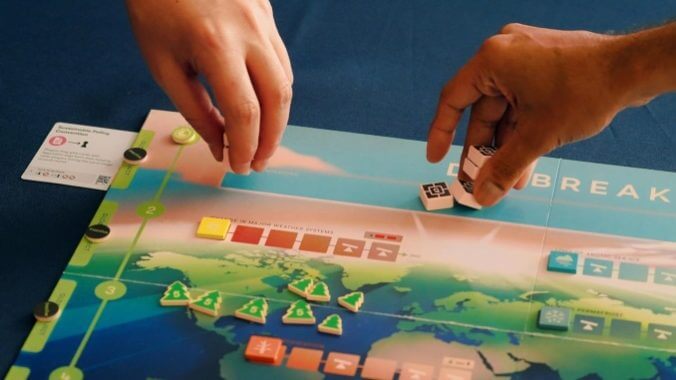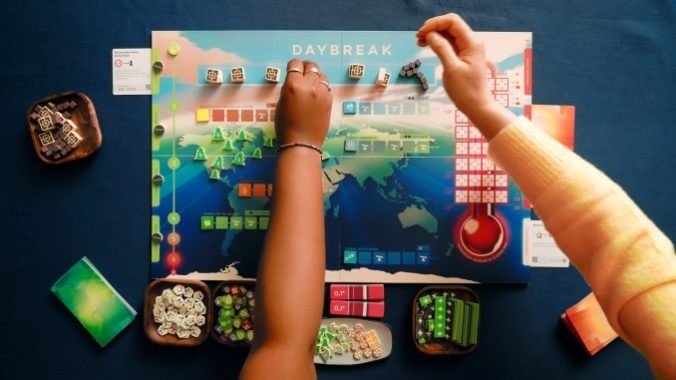Matthew Leacock is the master of the cooperative game, creating the massive hit game Pandemic and its many spinoffs, including the acclaimed three-part Pandemic Legacy series, as well as games like Forbidden Island and the brand-new Forbidden Jungle. All of these follow a similar set of rules where you’re competing to accomplish some goal, collecting a set of cards or objects, before whatever disaster or plague spreads too far across the board and triggers a loss for everyone.
Leacock’s newest game, Daybreak, is also a cooperative title, co-designed with Matteo Menapace, and this time takes on the serious and real threat of climate change. It’s also a completely new design, with very different mechanics from any of his previous cooperative games, with a slightly harder learning curve but a fantastic playing experience that works especially well with more players.
In Daybreak, players play as different regions of the world with different conditions—Europe and North America start with more sources of carbon dioxide, but have slower population growth and more technology to mitigate some of the effects of greenhouse gas emissions, while the developing world starts with a bit less of everything but will see its population and thus its energy demand soar as the game progresses. Players must work together to try to get to net-zero carbon emissions through a combination of reducing CO2 production, increasing green energy production, and increasing carbon sinks to sequester what’s produced, all before six rounds are up or any player exceeds 12 communities in crisis (which come from certain crisis cards or from failing to meet your population’s energy demand). If you do reach net-zero and still have space for more carbon remaining in the world’s forests and oceans, you achieve “Drawdown,” and must clear one last set of crisis cards to win and save the planet.
Each player starts with their unique set of five Local Project cards laid out above their player board, and as the game progresses, they’ll play further cards to those same five columns. Cards have one to three symbols in the upper right corner that allow them to interact with other cards in the same column or in your tableau. Most cards allow you to activate them at least once per round, with many of them requiring certain symbols in the same column for you to use them at all, and some cards become more powerful if you have more of the matching symbol in that column. You have the choice to play a card to the front of a column, covering most of the card that was already there (except its symbols), or to the back of it, so only its symbol(s) show and perhaps make the front card more powerful. You can also play cards to Global Projects that apply to all players, allowing you to use them during the round; or to Crisis cards to try to defuse them before they do bad things to the planet.

Players play cards simultaneously during the Project phase, and once everyone is done, you move to the hard parts and see if you’ve survived to play another round. First you count all of the carbon generated by all players from dirty energy sources and other sources like livestock, cars, industry, etc., and see how much is left over after the world’s forests and oceans have absorbed whatever they can. The excess carbon cubes go to the temperature track, with every five cubes bumping the global temperature up by 0.5°C, adding another temperature band to the board; for every band showing after this stage, you roll the climate die and move markers up tracks measuring things like ocean acidification, desertification, or arctic ice melting, all of which are, it turns out, very bad. Then you check all Crisis cards if you haven’t mitigated them already, with some of them face-down until the end of the round anyway. Most Crisis cards will add the aforementioned Communities in Crisis tokens to players’ boards if you can’t counter them with other tokens or cards, and if any player has more than 12, the game ends immediately. If not, you proceed to the next round. You have to finish the job by the end of round 6, however, or you lose anyway.
Daybreak is a lot—it’s a big step up in complexity from any of Leacock’s previous cooperative games, but in this case, it’s in service of both the game’s theme and the enjoyment of playing it. Climate change is real, whether you accept it or not, and it’s a complex subject that requires a far-reaching treatment like Daybreak gives it. There are multiple ways to win the game, but in general, you’re going to want to invest in one type of clean energy (wind, solar, nuclear), reduce a few types of your carbon emissions, and attack crises early before they overwhelm your constituent communities. If you try to do everything, you’ll lose—and in reality, people lose interest if they think the task is too hard or just insurmountable. Most of the cards ask you to make choices or sacrifices, often discarding a card from your hand to activate something else, which is hard when nearly every card is valuable and you want to do everything at once. Even just meeting energy demands, which means you can’t just kill off all your dirty energy sources at once because your people will revolt, brings Daybreak back to the reality of policymaking, where most reasonable people want clean energy … but few people are willing to pay more for it, or to use less energy to make a national or global switch possible.
I love the way Daybreak integrates tableau-building and hand management without becoming too much of either. The choice of whether to cover a card or add to its strength comes up multiple times a round and will have you thinking through possibilities—do I activate the front card now, then cover it and activate the new one? Do I play a card now and hope I get what I need to activate it later? (You can exchange cards with other players only in very rare circumstances, so you get the cards you get and you don’t get upset.) Removing the brown tiles from your board that represent carbon sources is very satisfying, but it’s slow going, and if you bank entirely on that, you’ll lose because you can’t get rid of enough of them in time. The game also requires you to think ahead about unforeseen disasters in the face-down Crisis cards or the rolls of the climate die, which you can prepare for in a way by collecting various Resilience tokens or setting up other cards that might let you ignore a single die roll or Crisis card’s effects. It strikes the right balance between planning for an uncertain future while facing the demands of the present, giving you a chance to win—not an easy one, mind you, but a chance—while also giving you the thrill or terror that comes with the end of each round to see if you’ve won, lost, or just get another go.
The game takes an hour and a half, with simultaneous plays moving things along and experienced players likely getting that down to an hour or so. It has a solo mode, which I think loses some of the interest that comes with multiple players because you see less of the deck and the starting set of Local Projects is a little boring. The game’s art is brightly colored and the text is very easy to read—there is a lot of text, however, so it’s language-dependent—while cards also have QR codes that send you to the game’s sight, with real-world context for the card’s project/crisis and an explanation of how the card works in the game. All materials in the game are sustainable, a welcome trend that has picked up steam in 2023 (Forest Shuffle and The Search for Lost Species did the same), with no plastics or textiles involved. It’s probably best for folks who’ve played a cooperative game or two before, or at least played some medium to heavy games so they’ll be familiar with mechanics like tableau-building, and I think the teach is probably not that quick. If any of that fits you and you want a bigger challenge than Pandemic or the Forbidden games, and you feel like saving the world from climate change (at least, on the tabletop), Daybreak is the hottest … um, coolest new cooperative game of 2023.
Keith Law is the author of The Inside Game and Smart Baseball and a senior baseball writer for The Athletic. You can find his personal blog the dish, covering games, literature, and more, at meadowparty.com/blog.

